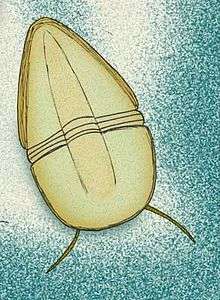Emucaris
| Emucaris fava Temporal range: Cambrian Stage 4 | |
|---|---|
 | |
| Emucaris fava | |
| Scientific classification | |
| Kingdom: | Animalia |
| Phylum: | Arthropoda |
| Stem-group: | Chelicerata |
| Order: | †Nektaspida |
| Family: | †Emucarididae |
| Genus: | †Emucaris Paterson et al., 2010 |
| Species: | † E. fava |
| Binomial name | |
| Emucaris fava Paterson et al., 2010 | |
Emucaris fava is an extinct species of soft-shelled trilobite-like arthropod of the nektaspid order from the Lower Cambrian (Cambrian Stage 4) of South Australia. It is the only species classified under the genus Emucaris.[1]
Etymology
The generic name is derived from the Emu Bay Shale, the deposit where the species was collected, and the Latin word caris meaning shrimp. The specific name fava is from the Latin word for honeycomb, for the ornamentation on its pygidial axis.[1]
Description
The outline of the dorsal exoskeleton of E. fava is pointed inverted egg-shaped, between 1.5 centimetres (0.59 in) and 3 centimetres (1.2 in) long and about 1⅔× as long as wide. The axis is up to 15% of the width of the body and only slightly raised. The semi-circular headshield (or cephalon) is about ½× as long as the tailshield (pygidium), and in between them four short thoracic body segments (somites). When disregarding the border, the pygidium of Emucaris is a triangle with a rounded termination, carrying a spine that ends at the outer rim of the border. There is no discernible segmentation visible. The axis in Emucaris is about one fifth of the pygidium and has a pattern of polygons of approximately equal area. The border of the cephalon is inconspicuous, and the border of the pygidium is longer than the somites. This border lacks ornamentation.[1]
Differences from Kangacaris
Kangacaris has only three thorax segments. The exoskeletal outline of Kangacaris is an inverted egg-shape. The axis of the pygidium of Kangacaris is ⅓ of the width of the body and clearly segmented. The axis of the pygidium Kangacaris lacks a terminal spine. The pygidial border of Kangacaris has 17 equally spaced ridges perpendicular to the edge of the border.
Distribution
Fossils of E. fava were collected from the Emu Bay Shale of Kangaroo Island, South Australia.
References
- 1 2 3 John R. Paterson, Gregory D. Edgecombe, Diego C. García-Bellido, James B. Jago, & James G. Gehling (2010). "Nektaspid arthropods from the Lower Cambrian Emu Bay Shale Lagerstätte, South Australia, with a reassessment of lamellipedian relationships" (PDF). Palaeontology 53 (Part 2): 377–402. doi:10.1111/j.1475-4983.2010.00932.x.